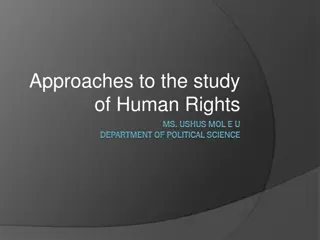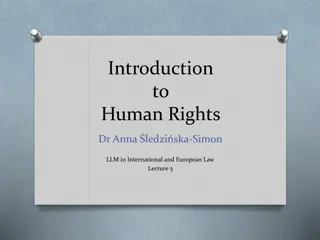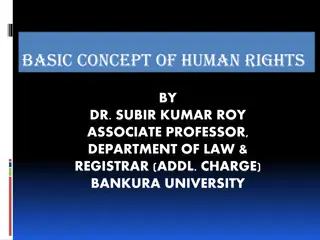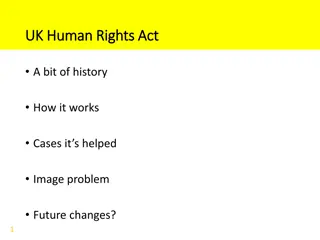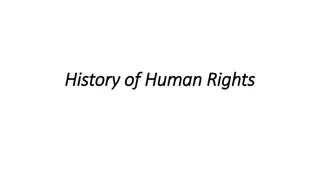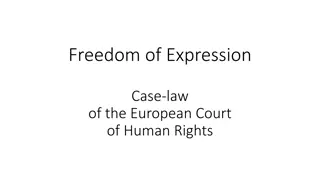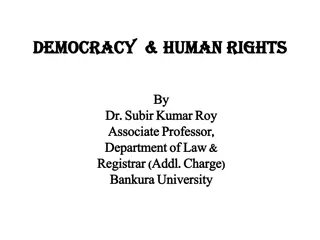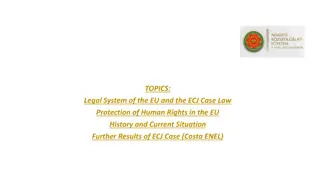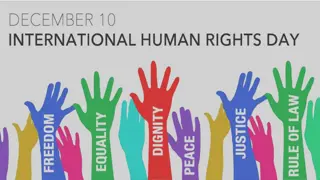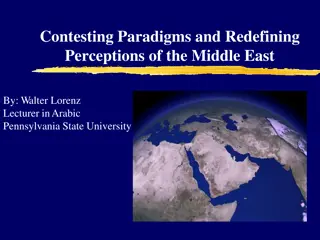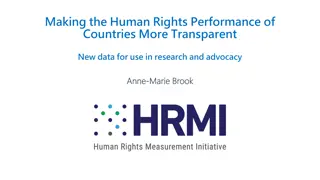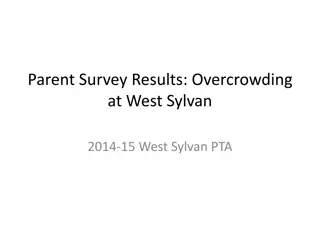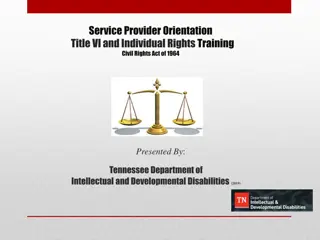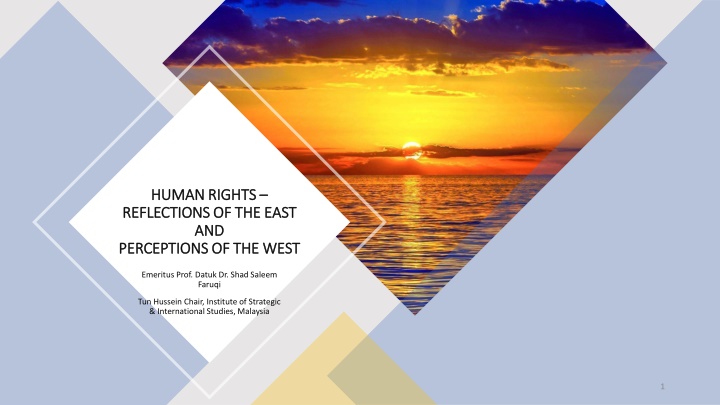
Perspectives on Human Rights: Reflections of the East and Perceptions of the West
Explore the complex topic of human rights through the lens of East and West perspectives, discussing the historical evolution, societal disparities, and ethical dilemmas surrounding civil, political, and socio-economic rights. Delve into the challenges faced by different regions in upholding human rights principles while navigating geopolitical realities.
Download Presentation

Please find below an Image/Link to download the presentation.
The content on the website is provided AS IS for your information and personal use only. It may not be sold, licensed, or shared on other websites without obtaining consent from the author. If you encounter any issues during the download, it is possible that the publisher has removed the file from their server.
You are allowed to download the files provided on this website for personal or commercial use, subject to the condition that they are used lawfully. All files are the property of their respective owners.
The content on the website is provided AS IS for your information and personal use only. It may not be sold, licensed, or shared on other websites without obtaining consent from the author.
E N D
Presentation Transcript
HUMAN RIGHTS HUMAN RIGHTS REFLECTIONS OF THE EAST REFLECTIONS OF THE EAST AND AND PERCEPTIONS OF THE WEST PERCEPTIONS OF THE WEST Emeritus Prof. Datuk Dr. Shad Saleem Faruqi Tun Hussein Chair, Institute of Strategic & International Studies, Malaysia 1
Introduction I am honoured and humbled by this invitation to speak about an extremely controversial and nebulous topic that is full of minefields and littered with genuine conflicts of learned opinions. 2
The challenge of the topic is multiplied by the multi-dimensional concept of human right and its expanding borders. 1. In the (Western) history of human rights, political and civil rights were the first concern. 2. Socio-economic protections followed soon thereafter. 3. Right to sustainable development is a more recent concern. 4. There is also the idea of the rights of future generations . 5. Peace and security provide the environment for the flourishing of human rights. 3
Some societies do badly in one category but better in others. For example, many Asian and African nations score poorly on political and civil liberties due to preventive detention, lack of press freedom, religious persecution, torture and extra-judicial executions. However, their record of alleviating poverty and disease is often commendable. 4
Europe and America score fairly well on political and civil rights within their borders but indulge in horrendous violations abroad through wars, invasions, toppling of elected regimes, economic embargoes, sale of weapons of mass destruction, export of toxic wastes and unfair trade practices. 5
For example, despite the covid-19 catastrophe, the 1994 WTO intellectual property provisions are being vigorously enforced against the Third World by Western corporations. 16% of the high-income countries have secured 60% of the vaccine. 84% poor countries will have access only by end of 2023. IP rights are taking precedence over coloured lives. 6
Two Asian authors, Jomo Sundram and Anis Chowdhry have recently written to ask whether the international regime of intellectual property is a cause of death and genocide? One is tempted to observe that (i) determining whether a human right is involved, and (ii) whether it has been violated is not an exercise that can ever be conducted objectively, fairly and impartially. 7
Despite this challenge of subjectivity, I wish to submit that this is an age of human rights at least of human rights advocacy. The quest for the inalienable rights of human beings has gained universal appeal. It is now generally recognised that state sovereignty is a shield against external aggression. It cannot be used as a sword against one s own nationals. Abuses anywhere deserve condemnation because injustice anywhere is a threat to justice everywhere (Martin Luther King). 8
The idea of human rights has gained universal appeal but there remain deep differences on the substantive details and content of human rights ideals. The universal core or paradigm seems to be surrounded by a penumbra or fringe in which the great minds of the East and the West do not meet. 9
At this point I wish to clarify and concede that neither the East nor the West is a homogeneous zone. Within each region and nation, diversity abounds, and relativity of values exists. When using terms like West and East, North and South, Occident and Orient, I am using the terms to refer to ancient value systems and not to geography. Australia e.g. is situated in SE Asia but has more cultural affinity with the West than with its coloured, Asian neighbours. 10
Despite the homogenization and Americanisation that globalization is bringing, many differences between America and Asia remain. Recognition of many core rights has not wiped away discord on a number of issues on which the reflections of the East (the Orient, the South) and the perceptions of West (the Occident, the North) differ considerably. I have selected fourteen such areas. 11
1. Are socio-economic rights more important than civil and political liberties? 2. Is the Asian values argument a camouflage for authoritarianism? 3. Is the instrumentality of electoral democracy suitable for bringing fundamental, structural changes to unjust socio-economic structures? 12
4. Is free market capitalism compatible with social justice? 5. Were human rights born in the crucible of Western civilisation? 6. Can human rights be reconciled with religion, conventional morality and custom? 7. Can individual rights be balanced with communitarian and family values? 13
8. Must duties go hand in hand with rights? 9. Is human dignity more important than human rights ? 10. Do threats to human rights emanate as much from private centres of power as from the state? 11. Must attention be turned to Western global dominance as a cause of the suppression of human rights and dignity in Asia and Africa? 14
12. In the field of human rights, is the moral superiority of the West a myth or reality? 13. Is globalisation a danger to justice, democracy and socio-economic rights in Asia? 14. Should human rights be subordinated to the war against terrorism ? 15
1. SOCIO-ECONOMIC RIGHTS VERSUS CIVIL AND POLITICAL LIBERTIES Are socio-economic rights entitled to the same protection as civil and political liberties? 16
International law recognises the connection between human rights and poverty alleviation Article 11 of the International Covenant on Economic, Social and Cultural Rights (1976). Article 14 of the Vienna Declaration. The United Nations Declaration on Eradication of Hunger. 17
Unfortunately, much of the Western-dominated human rights dialogue tends to concentrate on civil and political liberties and sees these liberties as the foundation on which socio-economic justice can be built. Most of the Western Constitutions in their Bill of Human Rights, do not mention the right to food, water, shelter, health, education and other socio-economic necessities of life. Contrast this with the Indian Constitution s chapter on Directive Principles of State Policy. Note also Africa s Banjul Charter. 18
At the other extreme is the argument of some Asian developmentalists that political freedoms must wait till a certain level of economic development is attained. 19
It is submitted that: Such sequencing or prioritisation is self-defeating. Bread and ballot, food and freedom must go hand in hand. Human rights are indivisible, interdependent and interrelated. Political and civil liberties cannot be separated from socio-economic protections because political and legal principles alone cannot ensure a regime of human rights. Human rights provisions must produce results. Law must be evaluated functionally. 20
2. ABSOLUTISM VERSUS RELATIVISM: THE ASIAN VALUES DEBATE Is there one universal concept of human rights or are there many conceptions? 21
The universalist perspective is supported by most Western nations and by the Western-educated elite of Asia. It holds that: human rights values are universal. impulses of human rights are recognised in a large number of international treaties 22
The Asian values argument is a crude attempt to avoid compliance with international standards Asian values, if they exist at all, are inferior to Western values. 23
On the other hand: Proponents of Asian values draw on the volksgeist theory of historicism that law is a reflection of the spirit of the people. It is relative to time and territory. Value pluralism is an undeniable reality. Relativists also point to the teaching of sociology that context determines content. 24
The relativists also submit that the Western claim that human rights values are universal is a thinly disguised neo-colonial argument for the perpetuation of cultural and economic hegemony by a Western civilisation that is used to domination. 25
It is submitted that the truth lies somewhere in between. Our thinking on human rights cannot be insulated from our religious, cultural, economic and historical insights. 26
The argument that there are no Asian values is a racist and ethnocentric argument. At the same time, it must be conceded that Asian values, have often been used to douse the flame of freedom. 27
Equally, American and European assertions are used to promote a narrow Westcentric view of human civilisation and to secure unfair advantages for Europe and America in the post cold war era. A middle path between these two extremes can be blazed. A human rights law with a settled core and a variable penumbra is a distinct possibility. 28
3. The Instrumentality of Democracy To most American and European observers, electoral democracy is the surest catalyst for the evolution of a regime of human rights. 29
While this is largely true - Majoritarian democracy is not always conducive to the protection of minority rights. Free and fair elections can return racists and fascists to power. Recent examples from Trump s America and Modi s India abound. 30
The imperatives of an electoral contest may actually increase ethnic and religious tensions. Democracy is good for incremental movements. But its ability to bring about unpopular, fundamental, structural, systemic changes is open to doubt. 31
Electoral democracy institutionalizes political corruption. It grants disproportionate power to pressure groups and unfair advantages to parties and candidates with funds to mount expensive campaigns. Around the world electoral democracy has proved no better than authoritarian systems in controlling oligarchies, monopolies, and elements of the deep state . 32
The connection between democracy and socio-economic development is by no means a necessary one. The economic rise of China and the endemic poverty in India are illustrative. Nevertheless, a trade-off between democracy and development is not justified. The prioritisation or sequencing argument must be rejected. The human rights world needs both democracy and development. 33
4. THE INSTRUMENTALITY OF A FREE MARKET ECONOMY A free-market economy is often seen as a pre-requisite to the promotion of a range of creative activities and entrepreneurship which are conducive to the gradual strengthening of human rights. Western thinking is deeply influenced by market capitalism, individualism and commercial rights. 34
However, there is insufficient recognition of the need to reduce extreme social inequalities and to redistribute wealth and property. The staggering concentration of wealth in the hands of a few; the existence of cartel capitalism; the exploitation of workers especially of those who make their products overseas; and the plundering of natural resources is very evident. Capitalistic theory does not emphasise the need for structural changes and social restructuring. It rejects limits on the right to property and limits on the right to trade freely in the capitalist market 35
The ruthless manner in which currency speculators impoverished the economies of much of Southeast Asia in the late 90s indicates that the connection between human rights and a free market is by no means an entirely beneficial one. 36
5. THE FOUNTAINS 5. THE FOUNTAINS OF OF FREEDOM FREEDOM In our times human rights have thrived best in the West. But historically speaking human rights were not born in the crucible of Western civilisation. Concern with the dignity of human beings was common to the religious traditions of the East. 37
America and Europe, after centuries of human rights violations, adopted this ethic only in the last half of the 20th century. The widely held belief that the human rights movement is a product of Anglo-Saxon, Protestant culture is historically unsupportable and is based on a biased, ethnocentric world-view. 38
In fact, all the ancient religions of the world promoted an ethic of humanity. Islam Christianity Judaism Hinduism Sikhism 39
6. HUMAN RIGHTS & RELIGIOUS RESTRAINTS Most Western legal systems hold it as a cardinal principle of political faith that law and morality, the state and religion must be clearly demarcated. This brand of militantsecularism denies any significant place for religious considerations in the human rights discourse. In contrast, 33 nations of the East (as compared to 9 of the West) adopt a State religion. Blasphemy is an offence in 30 Eastern societies (compared to 10 Western societies). 40
In most Asian and African societies, the religious basis of human rights is recognised and the political demand for personal liberties is subjected to religious, conventional and moral considerations. For example, homosexuality is an offence in 71 Asian and African societies as compared to 0 European legal systems. 41
The modern secular discourse on human rights should not ignore the religious convictions of the population in its formulation of the inalienable rights of human beings. Religious persons will not sacrifice their most firmly rooted convictions at the altar of human rights. If law is to be internalized it must not depart too far from the moral values of society and its entrenched customs. 42
We need a shared criteria between rational, secular morality and religious convictions. Let us not forget that practicing one s religion is itself a human right. Asian governments, more than Western, suffer this dilemma: can the authority of government and the obligation to obey its directives be persuasively defended in purely secular terms or is a religious underpinning required? (Kent Greenwalt, Religious Convictions and Political Choice, p.7) 43
7. INDIVIDUAL RIGHTS VERSUS COLLECTIVE WELFARE The Western version of human rights tends to emphasise the individual and his rights against society. Asian societies on the other hand subject individual rights to collective welfare and communitarian and family values to a much larger extent than in the West. Satanic Verses by Salman Rushdie is a case in point. 44
Legal attitudes towards blasphemy, pornography, sedition, treason, lese majeste are illustrative. Singapore law compels children to support their aged parents. Islamic law of wasiyat (wills) and inheritance puts strong obstacles in the path of someone who wishes to cut off his close relatives. 45
In Asian legal systems, the legislature and the courts view it as one of their essential functions to superintend the moral life of the community. In Western societies the demands of personal autonomy have gone so far that it is immoral to enforce morals . Whether it is blasphemy or pornography, or disrespect for your flag, nothing is sacred. There is belief in nothing, and this often leads to a belief in anything. 46
In Asia, considerations of social stability, peace and harmony are allowed to override the individual s right to express himself freely. Community interests trump individual rights in a far larger area than in the West. The lack of discipline against covid-19 restrictions in some Western societies is a case in point. What is needed is a doctrine of proportionality as a morally neutral balancing doctrine to resolve the tension between individual rights and community interests. 47
8. RIGHTS GO HAND IN HAND WITH DUTIES The dominant Western liberal philosophy emphasises an individual s rights but not his/her duties. In the covid-19 era, resistance by many Americans and Europeans to the covid-19 restraints is a case in point. 48
Asian scholars argue that rights must go hand in hand with duties. In India, the chapter on fundamental rights is accompanied by a chapter on fundamental duties. Some Asian scholars argue that there is no need to adopt an all or nothing approach as with free speech in America. The chapter on human rights must do both to confer rights and prescribe enumerated restrictions with the judiciary as the balance wheel. 49
9. 9. HUMAN RIGHTS OR HUMAN DIGNITY? HUMAN RIGHTS OR HUMAN DIGNITY? Western theory places emphasis on humanrights . Many Asian scholars prefer to use the term protection of human dignity as the primary aim of the law. The vocabulary of rights is shunned on the ground that the assertion of some rights is often incompatible with the preservation of human dignity. 50

